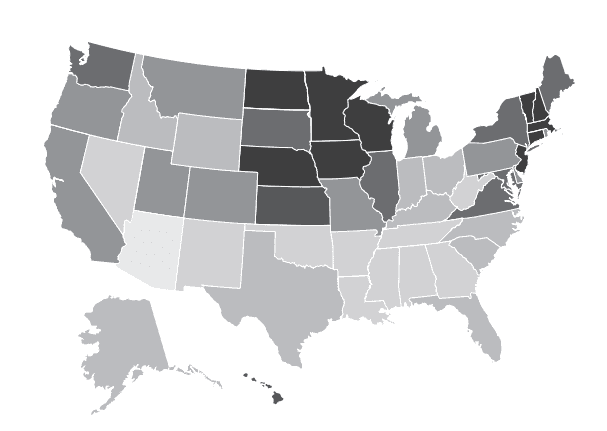
Over the years numerous studies have shown where the U.S. ranks on quality of life issues compared to other industrialized countries, and usually do so in an unflattering light. The news is usually discouraging on a wide range of issues, from health care to academic achievement to the infant mortality rate.
But a closer look at the country of 323 million offers a clearer picture at how well U.S. citizens fare at a local level. To that end, the most recent Opportunity Index evaluates all 50 states and the District of Columbia, and then drills down to almost 2,100 U.S. counties. Going beyond economics, the survey also includes indicators related to health, education and community. Opportunity Nation, the NGO leading this study, was joined in this effort by PwC and the nonprofit research organization Child Trends.
The country’s overall score is 52.4 out of 100 – a number that may appear jarring at first, but a more discerning look reveals improvements on a wide range of challenges, from the ability to secure health insurance to improved high school graduation rates. The problem, however, is that overall, the Opportunity Index concludes that opportunity is often segregated by race and ethnicity: Half of the counties with lower levels of opportunity are where people of color comprise the majority. Furthermore, no county with a population over 20 Native American or Alaska Native had a score higher than a “C.”
The good news is that across a macro level, life is improving for many citizens since the first Opportunity Index launched in 2011. More people are working, the country’s median household income is increasing and violent crime continues to decline. This year, 43 statewide opportunity scores saw improvement, while only seven states witnessed a decline. The results are also encouraging for residents of New England and the upper Midwest, as the index's top five ranked states are Vermont, Minnesota, Iowa, Massachusetts and North Dakota.
And in another hopeful sign, several demographic trends have witnessed improvement. One that stands out is that for the first time since the Opportunity Index launched, the population of disconnected youth (citizens aged 16-24 who are neither working or enrolled in school), has declined to under 5 million. According to the survey’s researchers, that number is important as along with incarceration rates, youth disconnection has a high correlation to the lack of opportunities.
In turn, at the county level, a high percentage of citizens with an associate’s degree or higher is most associated with economic opportunity. Hence more good news: the rate of adults with some level of post-secondary education is up in every state. Other trends, however, suggest long-term concerns. One of them is that the rate of preschool enrollment has declined in over half of the U.S. states, while only 16 schools have seen a boost in that rate.
In addition, the survey reveals where additional work needs to be done. Access to banking, which can help integrate citizens into local economies, has declined in almost every state and has improved in none. Voter registration rates have fallen in 37 states and the District of Columbia. And deaths from drug or alcohol poisoning, as well as those from suicide, have increased in 43 states.
Improvements across U.S. counties suggest a hopeful future, as almost 400 of them showed a large increase from 2016 to 2017 in what the survey calls their “opportunity grades.” Yet the Opportunity Index also helps explains the angst that lies behind the result of last year’s presidential election. For the 54 counties that saw a significant decrease in their scores, two-thirds are in the U.S. South; and the vast majority of them are rural counties with a population of 100,000 or less. Too many people are being left behind, and a large number of them of them are clustered where public health, educational opportunities and job creating are stalled.
Image credit: Opportunity Index

Leon Kaye has written for 3p since 2010 and become executive editor in 2018. His previous work includes writing for the Guardian as well as other online and print publications. In addition, he's worked in sales executive roles within technology and financial research companies, as well as for a public relations firm, for which he consulted with one of the globe’s leading sustainability initiatives. Currently living in Central California, he’s traveled to 70-plus countries and has lived and worked in South Korea, the United Arab Emirates and Uruguay.
Leon’s an alum of Fresno State, the University of Maryland, Baltimore County and the University of Southern California's Marshall Business School. He enjoys traveling abroad as well as exploring California’s Central Coast and the Sierra Nevadas.














